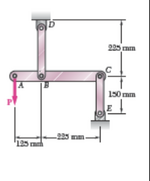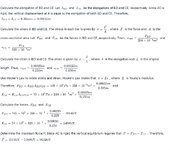Connection BD is made of brass (E = 105 GPa) and has a cross-section of 256 mm^2. Connection CE is made of aluminum(E = 73 GPa) and has a cross-section of 320 mm^2.
• Determine the maximum force P that can be applied vertically at point A if the displacement of A must not exceed 0.35 mm.
- Suppose that element AC is rigid.
I thought of writing the relations between the tension on each connection BD and CE and then imposing that the elongation of the two is equal. Then since BD therefore lengthens the tie rod and CE therefore shortens the strut, imposing that the algebraic sum of the two forces is equal to P.
• Determine the maximum force P that can be applied vertically at point A if the displacement of A must not exceed 0.35 mm.
- Suppose that element AC is rigid.
I thought of writing the relations between the tension on each connection BD and CE and then imposing that the elongation of the two is equal. Then since BD therefore lengthens the tie rod and CE therefore shortens the strut, imposing that the algebraic sum of the two forces is equal to P.


